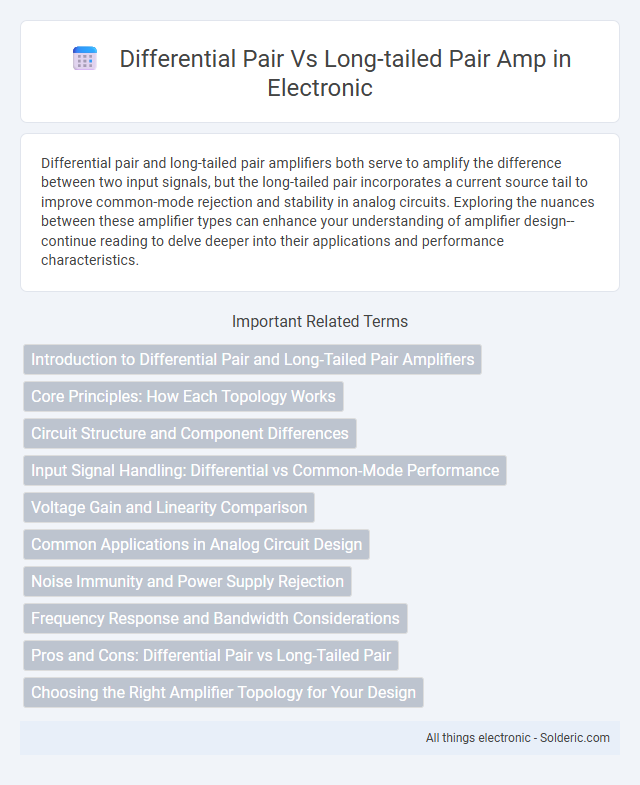Differential pair and long-tailed pair amplifiers both serve to amplify the difference between two input signals, but the long-tailed pair incorporates a current source tail to improve common-mode rejection and stability in analog circuits. Exploring the nuances between these amplifier types can enhance your understanding of amplifier design--continue reading to delve deeper into their applications and performance characteristics.
Comparison Table
| Feature | Differential Pair Amplifier | Long-Tailed Pair Amplifier |
|---|---|---|
| Basic Structure | Two matched transistors sharing inputs | Two transistors with a current source "tail" |
| Input | Two differential inputs | Two inputs with balanced tail current |
| Output | Single-ended or differential output | Generally differential output |
| Common-Mode Rejection Ratio (CMRR) | High, due to differential inputs | High, enhanced by constant tail current |
| Biasing Method | Depends on individual transistor biasing | Uses a constant current tail for bias stability |
| Applications | Signal amplification, mixers, analog circuits | Input stage in operational amplifiers, comparators |
| Advantages | Good linearity, noise rejection | Stable biasing, improved CMRR |
| Disadvantages | Biasing complexity | Requires precise tail current source |
Introduction to Differential Pair and Long-Tailed Pair Amplifiers
Differential pair amplifiers consist of two transistors sharing a common emitter or source node to amplify the voltage difference between two inputs, providing high gain and common-mode noise rejection. Long-tailed pair amplifiers are a specific type of differential pair with a high-impedance tail current source that improves linearity and stability by maintaining constant tail current. Both configurations are fundamental in analog circuit design, widely used in operational amplifiers and balanced signal processing for precise differential signal amplification.
Core Principles: How Each Topology Works
A differential pair amplifier uses two transistors with their inputs receiving differential signals, amplifying the voltage difference while rejecting common-mode noise, essential for high-precision applications. The long-tailed pair amplifier, a specific type of differential pair, incorporates a current source tail to establish a constant tail current, improving linearity and gain stability by controlling the differential pair's bias conditions. Both topologies exploit transistor symmetry for differential amplification, but the long-tailed pair's dedicated tail current source enhances performance under varying signal conditions.
Circuit Structure and Component Differences
Differential pair amplifiers consist of two identical transistors sharing a common emitter tail resistor, designed for balanced input signals and offering high common-mode rejection. Long-tailed pair amplifiers also use two transistors but incorporate a high-value resistor or current source in the tail to improve bias stability and linearity under varying load conditions. Your selection between the two depends on the required input balance, noise performance, and overall circuit stability for the application.
Input Signal Handling: Differential vs Common-Mode Performance
Differential pairs excel in amplifying the difference between two input signals while inherently rejecting common-mode noise, resulting in high common-mode rejection ratio (CMRR) and improved signal integrity. Long-tailed pair amplifiers provide balanced operation with enhanced linearity but typically offer moderate common-mode performance compared to ideal differential pairs. The choice between these configurations depends on the required balance between differential gain accuracy and common-mode noise suppression for specific analog circuit applications.
Voltage Gain and Linearity Comparison
Differential pairs typically offer moderate voltage gain with excellent linearity due to symmetrical device operation and balanced input signals. Long-tailed pair amplifiers provide higher voltage gain by leveraging a constant current tail, which improves transconductance and reduces distortion for superior linearity under varying input conditions. Both configurations are fundamental in analog design, but the long-tailed pair is often preferred where higher gain and linearity are critical.
Common Applications in Analog Circuit Design
Differential pairs are widely used in analog circuit design for input stages of operational amplifiers, mixers, and comparators due to their high common-mode rejection ratio and precise differential signal amplification. Long-tailed pair amplifiers excel in applications requiring stable biasing and improved linearity, such as in voltage-controlled amplifiers and transistor-level analogue multipliers. Your choice between these topologies depends on specific requirements like noise performance and linearity in precision analog circuits.
Noise Immunity and Power Supply Rejection
Differential pairs exhibit superior noise immunity by effectively canceling common-mode signals and external interference, making them ideal for high-precision applications. Long-tailed pair amplifiers enhance power supply rejection ratio (PSRR) through a current source biasing that stabilizes operating points against supply variations. Both topologies improve signal integrity, but differential pairs typically offer higher noise suppression, while long-tailed pairs provide robustness in fluctuating power environments.
Frequency Response and Bandwidth Considerations
Differential pairs typically exhibit wider bandwidth and improved frequency response due to symmetric input signals reducing even-order harmonics and common-mode noise, making them ideal for high-frequency applications. Long-tailed pair amplifiers have limited bandwidth as their tail current source introduces parasitic capacitances that restrict high-frequency performance and induce phase shifts. Careful transistor sizing and biasing in differential pairs can further optimize frequency response, whereas long-tailed pairs often require additional compensation techniques to enhance bandwidth.
Pros and Cons: Differential Pair vs Long-Tailed Pair
Differential pair amplifiers offer superior common-mode noise rejection and better linearity, making them ideal for precision signal amplification, but they can be more complex to design and consume more power. Long-tailed pair amps provide a simpler and more cost-effective solution with easier biasing and good gain, though they generally have lower common-mode rejection and increased distortion compared to differential pairs. Understanding these pros and cons helps you choose the right amplifier topology for your specific circuit requirements.
Choosing the Right Amplifier Topology for Your Design
Differential pair and long-tailed pair amplifier topologies offer distinct advantages in noise rejection and linearity, making the choice critical for your design's performance. Differential pairs excel in high common-mode noise environments by providing balanced input signals, while long-tailed pairs emphasize improved gain stability and predictable bias currents. Selecting the appropriate topology depends on your specific application demands, such as signal integrity, power consumption, and stage complexity.
Differential pair vs Long-tailed pair amp Infographic

 solderic.com
solderic.com